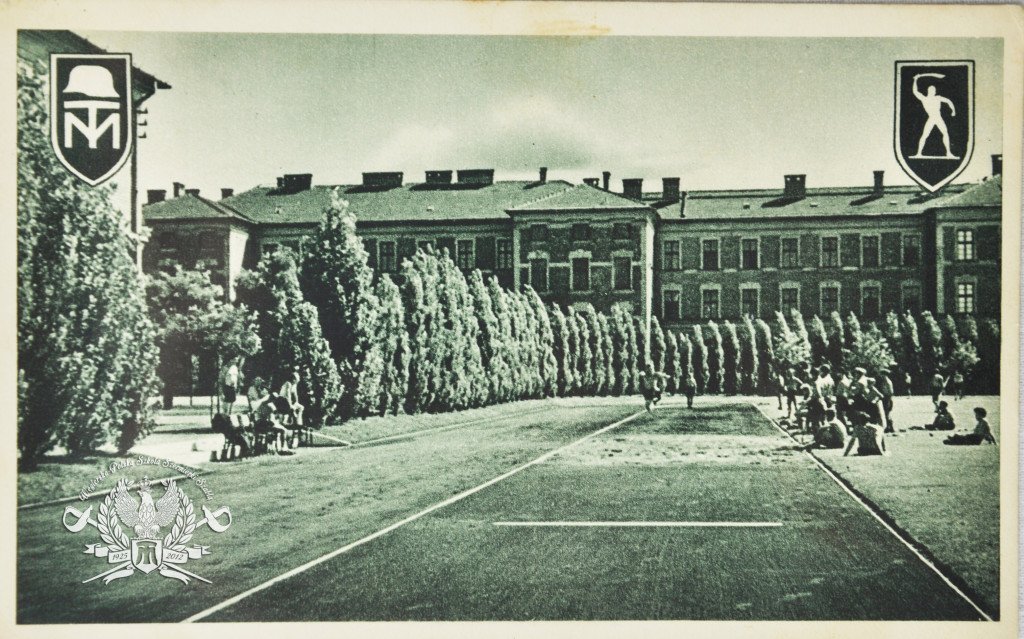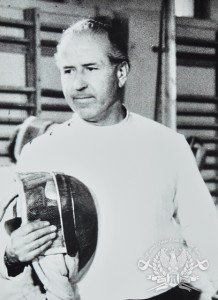The Hungarian Sabre Fencing School has been teaching military sabre fencing based on the methodology developed in the Miklos Toldi Royal Hungarian Institute of Military Sports and Fencing (Miklós Toldi és Honvéd Sporttanár Vívómester képző Intézet) founded in 1925.
The Miklos Toldi Institute became a prestigious fencing academy in the 1930s. The school was involved in research dedicated to the development of fencing techniques. It also taught fencing with three weapons: sabre, épée and foil. The Institute’s most important and most advanced weapon in technical terms was sabre. Only the military could “enter the lists” of this prestigious school. In its history, only one student was a civilian: Aladár Gerevich, outstanding and prize-winning fencer.
After Borsodi’s retirement, two eminent alumni of the Institute, fencing masters János Szűcs and János Kevey took over the directorship of the academy.
LÁSZLÓ BORSODI
László Borsodi graduated from two fencing schools. He started at the Wiener-Neustadt Military Academy (Austria) under the guidance of Luigi Barbasseti. Then he studied at the Budapest Ludoviká Military School where he also served out his two year assistantship and earned the rank of master.
With his extensive knowledge and experience, he developed his own combat system and teaching methodology for sabre fencing which was soon called the contemporary Hungarian style. Training sessions based on his system produced excellent results. Many-time Olympic medallists were weaned on these methods: György Piller, Aladár Gerevich and many prominent fencing masters spearheaded by János Szűcs and János Kevey. Borsodi was an absolute perfectionist, extremely demanding for himself and his students. He could spend entire days working with György Piller on new fencing techniques and strategies.
After Borsodi’s retirement, two eminent alumni of the Institute, fencing masters János Szűcs and János Kevey took over the directorship of the academy.
JÁNOS SZŰCS
The first, János Szűcs, took on fencing at the Institute at the age of 22. When Borsodi retired in 1936, Szűcs took over as the chief sabre fencing master and became the head of the Miklos Toldi Institute. In 1938, he went to Paris to teach sabre and learn épée and foil fencing under the guidance of French masters.
During World War 2, he was sent to a French prisoner-of-war camp . After the war, there was nothing he could go back to as the vommunists appropriated all his belongings. In 1948, he became the head coach of the Hungarian Olympic team in sabre. He was behind sport successes of such fencers as: Aladár Gerevich (who was also earlier taught by László Brosodi), Pál Kovács, Tibor Berczelly, Bertalan Papp, Attila Keresztes, Szabolcs Örley and Tibor Pézsa. Each of them earned his Olympic gold medal and numerous World Championships. The last mentioned fencer, Tibor Pézsa, was the favourite disciple of his maestro. When János Szűcs suffered from Parkinson’s disease three years before his death, it was Pézsa who took care of him, and arranged for his master’s funeral with ceremonial military procession and honours after his death in 1976.He was behind sport successes of such fencers as: Aladár Gerevich (who was also earlier taught by László Brosodi), Pál Kovács, Tibor Berczelly, Bertalan Papp, Attila Keresztes, Szabolcs Örley and Tibor Pézsa
TIBOR PÉZSA
Tibor Pézsa, called the “Sabre Fencing General”, world champion and Olympic champion in sabre fencing. At the age of eighteen, he began his fencing career in Ester Gomp, then he learned sabre in the Budapest Honvéd Club under the command of Major Istvan Bujnowski (1957). Finally, he trained under the tutelage of János Szűcs, fencing master, who was first an alumnus of the pre-war Miklos Toldi Institute, and then its chief swordsman. In late 1950s, Tibor Pézsa earned his first successes in competitions. In 1962, he won his silver medal at the World Championship held in Buenos Aires. Two years later he scored his greatest success winning a gold medal at the Olympic Games in Tokyo (1964).
At first, his teacher, János Szűcs taught him competitive fencing only. However, when Pézsa became the Olympic champion, Szűcs started passing to his favourite disciple his knowledge of military fencing gained in the Miklos Toldi Institute.
In 1973, Tibor Pézsa decided to retire as a fencer and began his coaching career. From 1978 to 1982, he led the Hungarian national team of sabre fencers. In 1985-1989, he coached the German and Saudi Arabian teams. In 1989, he became an advisor to the Hungarian army. Today he remains in the shadows, and teaches military fencing to very few disciples.
JÁNOS KEVEY
Apart from János Szűcs, there was one more officer from the Miklos Toldi Institute who had similar successes as a fencing master: Major János Richter Kevey. His first encounter with sabre fencing took place in secondary school. He continued his training as a university student. His first master was Gustav Tomanóczy, fencing teacher at the Military Institute for Fencing and Gymnastics Teachers’ Development of Wiener-Neustadt. In 1930, he began training at the university club which qualified him for his first successful competitions. In 1935, he enrolled at the Miklos Toldi Institute to graduate in 1937 as a master of three weapons (sabre, épée and foil). The next year, he came to Poland to teach fencing, and was awarded the Order of Polonia Restituta for his achievements in this area. In 1940, he won the title of the Champion of Hungary in épée fencing. From 1947 to 1958, he coached the Polish national team, and was behind the successes of such famous Polish fencers as Jerzy Pawłowski, Wojciech Zabłocki, Ryszard Zub, Marian Kuszewski and Andrzej Piątkowski. János Kevey was not a lenient coach. His charges began their training every morning between 6 and 7. His training methods were harsh – swimming in icy water in winter or mountain climbing with heavy backpacks in the summer. But his results were remarkable. Kevey authored that perfect flash and footwork of Polish fencers.
In 1952, he published “Saber Fencing” (written in Polish). In 1959, he left Poland for Italy where he worked as a coach in Turin, Rome and Milan. In 2007, his star was unveiled on the Walk of Sports Fame in Władysławowo.
We preserve the historical knowledge of non-sport sabre art of the elite Toldi Miklós Institute of Military sports and fencing.
Fencing is a noble activity which has always been the preserve of the upper and better educated echelons of society. Military saber fencing – the mother of its sport variety – is a pursuit for all those who would like to experience living history. Anyone can pick up a sabre, weigh it in their hands and cross the blades with their partner while learning fencing techniques. Eventually, the time for the first duels will come too.
We have been teaching fencing as used to be practised by military officers. At the Hungarian-Polish Sabre Fencing School, we preserve the traditions of teaching combat fencing rooted in the philosophies of the eliteMiklos Toldi Royal Hungarian Institute of Military Sports and Fencing (Miklós Toldi és Honvéd Sporttanár Vívómester képző Intézet) founded in 1925. Before World War 2, Hungarian fencing masters of the Institute trained Polish officers too.
Atgal
 .
.


